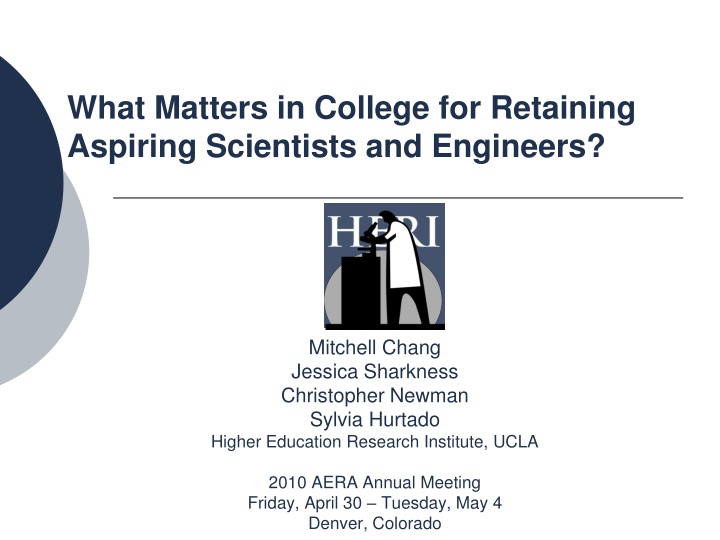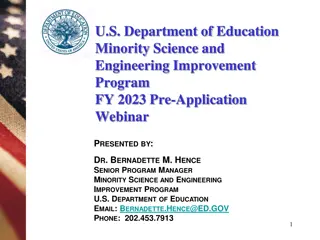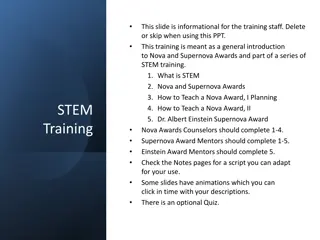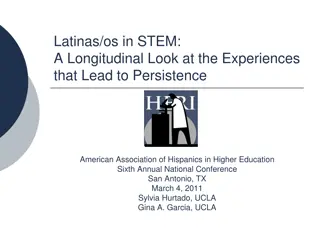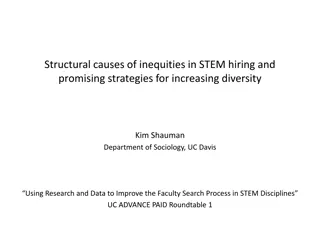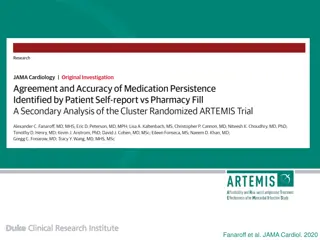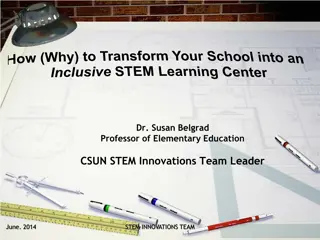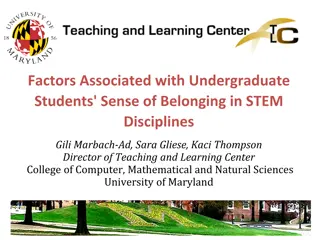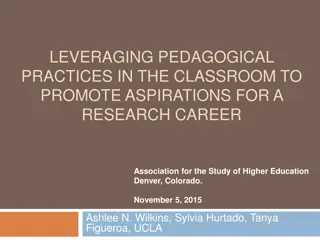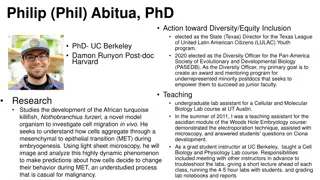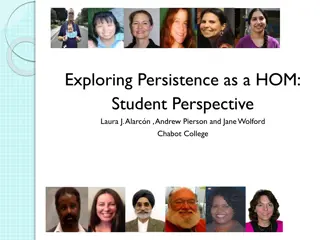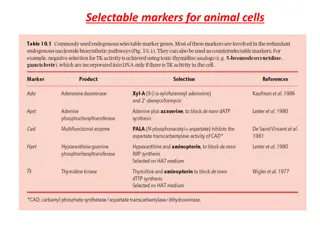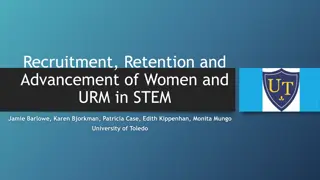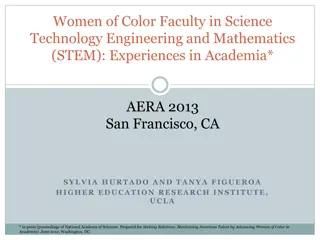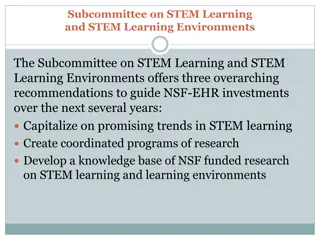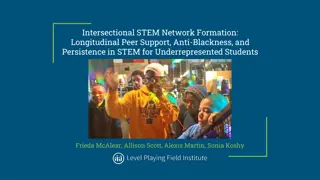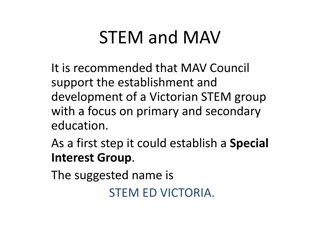Factors Influencing STEM Major Persistence Among Underrepresented Minority Students in College
This study examines the retention of aspiring scientists and engineers in STEM majors, focusing on underrepresented minority (URM) students. It investigates differences in intentions and persistence across racial groups, considering the impact of college experiences. Factors influencing STEM major persistence among URM students are explored using longitudinal data from the CIRP Freshman Survey and Senior Survey.
Uploaded on Sep 07, 2024 | 4 Views
Download Presentation

Please find below an Image/Link to download the presentation.
The content on the website is provided AS IS for your information and personal use only. It may not be sold, licensed, or shared on other websites without obtaining consent from the author.If you encounter any issues during the download, it is possible that the publisher has removed the file from their server.
You are allowed to download the files provided on this website for personal or commercial use, subject to the condition that they are used lawfully. All files are the property of their respective owners.
The content on the website is provided AS IS for your information and personal use only. It may not be sold, licensed, or shared on other websites without obtaining consent from the author.
E N D
Presentation Transcript
What Matters in College for Retaining Aspiring Scientists and Engineers? Mitchell Chang Jessica Sharkness Christopher Newman Sylvia Hurtado Higher Education Research Institute, UCLA 2010 AERA Annual Meeting Friday, April 30 Tuesday, May 4 Denver, Colorado
Background U.S. Employment in STEM Demographics 3.9%4.5% White Asian American Black Latino 17.2% 77.3% National Science Foundation, 2009
Background Persistence in STEM: Percentage of 2004 STEM aspirants who completed STEM degrees within five years 50.0% 42.0% 40.0% 33.0% 30.0% 22.1% 18.4% 20.0% 10.0% 0.0% White Asian American Black Latino Higher Education Research Institute, 2010
Previous Research Academic preparation Financial need Joining a pre-professional or departmental club Family support, role models, and mentors Structured research programs
Conceptual Model Academic & Social Experiences Pre-College Factors & Pull-Factors Initial Final Persistence Commitments Commitments Pre-College Ability Formal/Inform al Academics with Faculty Psychosocial Factors Social Experiences Educational Goal Reenrollment in Higher Education Institution Financial Assist/Need Educational Aspirations Campus Climates Institutional Commitment Encouragement & Support Validating Experiences Environmental Pull Factors Mentoring Experiences Adapted from Nora, Barlow, Crisp (2005)
Research Questions Among all students who started college with an interest in majoring in a STEM field, are there significant differences in the proportion of URM students (versus Whites and Asians) who follow through on these intentions? If so, are these differences moderated by college experiences? What factors contribute to the STEM major persistence of URM students?
Data Data Source and Sample: Longitudinal data: 2004 CIRP Freshman Survey & 2008 CIRP Senior Survey 3,670 students overall 1,634 URM students (812 Latino, 626 Black, 196 Native American) Dependent Variable ( STEM persistence ): Students followed through with first-year intentions to major in STEM field (1), student switched to another major (0) STEM persistence, by race 100% 73.5% 80% 63.5% 62.8% 58.9% 56.5% 60% 40% 20% 0% Asian/ Pacific Islander White Native American Latino/a Black/ African American
Analyses Hierarchical Generalized Linear Modeling (HGLM) Appropriate for multi-level data with dichotomous outcome Two stages of analyses: 1. HGLM analysis of student-level predictors of STEM persistence for all-student sample, focusing on significance of race effects 2. HGLM analysis of student and institution-level predictors of STEM persistence for URM students only Significant predictors reported as delta-p ( -p) statistics
Results: Research Question 1 Are there significant differences in the proportion of URM students (versus Whites/Asians) who follow through on STEM major intentions? Model 1 Model 2 Race Main Effects Native American Latino/a Black/African American Blocks of variables included in the model: Gender, mother s ed. College Experiences No No No No Yes (-) Yes (-) X X X Latinos, Blacks significantly less likely to persist in STEM (vs. Asians & Whites) when only demographics are considered Effect is moderated by college experiences
Results: Research Question 2 What factors contribute to the STEM major persistence of URM students? Only significant predictors shown Student-Level Predictors Delta-P High School Academic Preparation/Pre-College Characteristics Math + Verbal SAT score (100-pt increments) Academic Self-Concept Social Self-Concept Aspire to medical degree (vs. Bachelor s) College Experiences Participated in undergrad research program Studied with other students Joined club/org. related to major Faculty interaction (factor) Worked full-time while in school 6.8% 1.0% -0.8% -11.5% 17.4% 13.6% 9.3% -6.8% -9.7%
Results: Research Question 2 What factors uniquely contribute to the STEM major persistence of URM students? Only significant predictors shown Institution-Level Predictors Delta-P Institutional Characteristics Institutional Selectivity (100-pt increments) Percent of students majoring in STEM (10-point increments) -13.0% 5.57% Model Statistics Explained variance at Level 2 Baseline probability of STEM major persistence 0.69 0.58
Discussion Experiences in college and college contexts can have a significant influence on student persistence in STEM majors, above and beyond high school preparation Sponsored Research Programs (MARC, MBRS, etc.) Studying with other students Institutional Selectivity Proportion of students majoring in STEM
Contact Information Faculty and Co-PIs: Sylvia Hurtado Mitchell Chang Postdoctoral Scholars: Kevin Eagan Josephine Gasiewski Administrative Staff: Aaron Pearl Graduate Research Assistants: Christopher Newman Minh Tran Jessica Sharkness Monica Lin Gina Garcia Felisha Herrera Cindy Mosqueda Juan Garibay Papers and reports are available for download from project website: http://heri.ucla.edu/nih Project e-mail: herinih@ucla.edu Acknowledgments: This study was made possible by the support of the National Institute of General Medical Sciences, NIH Grant Numbers 1 R01 GMO71968-01 and R01 GMO71968-05 as well as the National Science Foundation, NSF Grant Number 0757076. This independent research and the views expressed here do not indicate endorsement by the sponsors.
